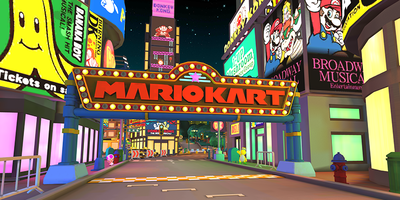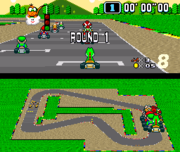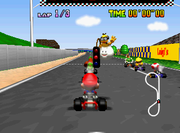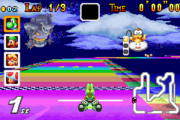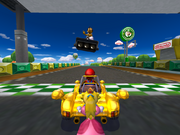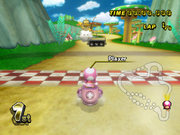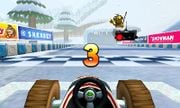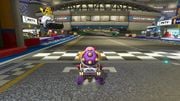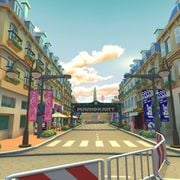Finish line (object): Difference between revisions
m (Ahemtoday moved page Finish Line (object) to Finish line (object): Koopa Con Carne has brought it up and I've been thinking about it for a bit beforehand. I don't think this is an official term that gets capitalized like this, so the article name needs to reflect that. Unfortunately, we still need to distinguish it from Finish Line (microgame).) |
mNo edit summary |
||
| Line 1: | Line 1: | ||
[[File:MKT New York Minute Website Scene.png|thumb|400px|[[Tour New York Minute|New York Minute]]'s finish line in ''[[Mario Kart Tour]]'']] | [[File:MKT New York Minute Website Scene.png|thumb|400px|[[Tour New York Minute|New York Minute]]'s finish line in ''[[Mario Kart Tour]]'']] | ||
'''Finish | '''Finish lines''' are checkered lines with signs overhead that appear at least once in every race course in the [[Mario Kart (series)|''Mario Kart'' series]]. Racers begin on a '''starting grid''' behind one. Crossing one afterward marks the beginning of another lap or section, or the end of the race. | ||
Starting | Starting grids position racers in a grid, with each column of racers placed further back than the last. The frontmost column is always on the outside of the first turn, which is the same side [[Lakitu (Mario Kart referee)|Lakitu]] shows up on after crossing the line. The size of the grid varies depending on the game. | ||
{| class="wikitable" | {| class="wikitable" | ||
Revision as of 14:39, February 21, 2023
Finish lines are checkered lines with signs overhead that appear at least once in every race course in the Mario Kart series. Racers begin on a starting grid behind one. Crossing one afterward marks the beginning of another lap or section, or the end of the race.
Starting grids position racers in a grid, with each column of racers placed further back than the last. The frontmost column is always on the outside of the first turn, which is the same side Lakitu shows up on after crossing the line. The size of the grid varies depending on the game.
| Game | Racers | Size |
|---|---|---|
| Super Mario Kart | 8 | 2×4 |
| Mario Kart 64 | 8 | 2×4 |
| Mario Kart: Super Circuit | 8 | 2×4 |
| Mario Kart: Double Dash!! | 8 | 4×2 |
| Mario Kart DS | 8 | 4×2 |
| Mario Kart Wii | 12 | 3×4 |
| Mario Kart 7 | 8 | 4×2 |
| Mario Kart 8 (Deluxe) | 12 | 6×2 |
| Mario Kart Tour | 8 | 4×2 |
| Mario Kart Arcade GP series | 6 | 2×3 |
History
Super Mario Kart
Finish lines first appear in Super Mario Kart. Unlike in future titles, they have no overhead structure. All finish lines in this game have white and black checkers. Since Mario Kart Wii, courses from this game have had gates added to their finish lines.
Super Mario Kart also features visible spaces for each starting grid column before each course's finish line. The spaces are wide, and accommodate for two misaligned columns per row, totaling four rows of spaces. What these spaces look like depends on the type of road for the course's theme (for instance, Mario Circuit 1 features white, bracket-shaped spaces on its asphalt road, Choco Island 1 has thin lines drawn into the dirt road, and Rainbow Road uses thick stripes that matches with the size of the course's tiles). Since Mario Kart DS and Mario Kart Wii have no visible spaces for the columns, these would be removed for the Super Mario Kart courses that appear in those games, but would be re-applied for those that re-appear in Mario Kart 7, Mario Kart 8, Mario Kart 8 Deluxe, and Mario Kart Tour
Mario Kart 64
In Mario Kart 64, finish lines are usually checkered with black and white, though some tracks are colored black and yellow while Moo Moo Farm, Sherbet Land and D.K.'s Jungle Parkway have fully yellow colored lines. For the first time, they have overhead banners. In this game, they have a consistent design with a black background, checkered border, and the classic Mario Kart logo in a green-to-orange gradient.
Mario Kart 64 did not have visible spaces for their starting grid. However, the Mario Kart 64 courses that would re-appear in Mario Kart 7 and beyond would have visible spaces added.
Mario Kart: Super Circuit
Finish lines return to their Super Mario Kart design in Mario Kart: Super Circuit, being black and white and lacking any overhead banner. Similarly to that game, they have had gates added to them in Mario Kart Wii and following games.
Also like Super Mario Kart, Mario Kart: Super Circuit reintroduces visible spaces for the starter grid columns. While still accommodated for two columns per row, the spaces are made a bit smaller. The appearance of the spaces still change per course, but are most commonly bracket-shaped. The Extra Courses returning from Super Mario Kart retain the appearance of their respective starting grid spaces.
Mario Kart: Double Dash!!
Mario Kart: Double Dash!! marks the first appearance of unique gate designs, logos, logo colors, and checkerboard colors. While many still use the classic Mario Kart logo, others have a simpler logo made from the same font as the game's course logos, Sherbet Land and Mushroom City share a unique font, and Rainbow Road has a unique holographic logo being emitted from one pipe into another.
Like in Mario Kart 64, Mario Kart: Double Dash!! does not feature visible starting grid spaces, and would not be featured in future Mario Kart titles up until Mario Kart 7 (with the Mario Kart: Double Dash!! courses that would be re-added in Mario Kart 7 and beyond also featuring them now). Mario Kart: Double Dash!! is also the first Mario Kart that alters the size of the starting grid, now only featuring two rows before the finish line, which would be the common size in future Mario Kart games. This meant that each row now features four columns, as opposed to two columns like in previous titles.
Mario Kart DS
Mario Kart DS retains unique gate designs. Its nitro tracks use either the classic logo (despite the change to the logo of the game itself), a scoreboard-like gate topped with "MarioKart" styled like the Nintendo logo, repeating alternately in white on black and red on white, or (exclusive to Waluigi Pinball) a neon sign with a unique font.
Its retro tracks retain the courses' original gate designs, including the lack of them in SNES and GBA courses.
Peach Gardens does not have its gate above its finish line, as instead its gate is near the edge of the lake. It is the only track in the series with this property, as this is not even true of its reappearances in Mario Kart Wii, Mario Kart Tour, and Mario Kart 8 Deluxe.
Mario Kart Wii
Mario Kart Wii uses the classic logo (again, despite the changes to the logo of the game itself) for every track's finish line, though there is additional text alongside it on Toad's Factory ("MUSHROOM CUP FINAL ROUND") and Mario Circuit ("MARIO KART GRAND PRIX").
It is the first game in the series to change the gates of its retro tracks from their original appearance. SNES and GBA tracks receive Mario Kart 64's banner design, while Mario Kart DS's scoreboard gate (present on DS Yoshi Falls and DS Desert Hills) has been altered to include the classic logo as a center panel instead of the pattern at the top. Additionally, DS Peach Gardens has had its gate relocated on top of its finish line.
Due to Mario Kart Wii including twelve racers in a match now, the starting grid size had to change accordingly, now featuring four rows, with three columns each.
Mario Kart 7
Mario Kart 7 begins using the modern logo on new tracks.
Mario Kart 7 is the first game to introduce section-based tracks with multiple finish lines.
Mario Kart 7 would see the return of visible starting grid spaces, last seen in Mario Kart: Super Circuit. These are bracket-shaped, small enough to precisely fit a single racer, and accommodated for four columns per row, returning to the two-row structure size as used in Mario Kart: Double Dash!! and Mario Kart DS.
 This section is a stub. You can help the Super Mario Wiki by expanding it.
This section is a stub. You can help the Super Mario Wiki by expanding it.
Mario Kart 8 / Mario Kart 8 Deluxe
Mario Kart 8 features redesigns for the starting gates for each classic course, giving nearly all of them a unique design. GCN Yoshi Circuit, GBA Cheese Land, GBA Ribbon Road, and all courses originating from Mario Kart DS and Mario Kart Wii now use the modern Mario Kart logo for their gates, as opposed to the the classic logo they used before. Additionally, the classic logo for the remaining classic courses has been redesigned in the style of the modern Super Mario logo, first used in Super Mario 3D Land.
Animal Crossing, Hyrule Circuit, Mute City, Big Blue, and Yoshi's Island have the logos of the series on which they are based on their gates instead of the Mario Kart logo.
Since each race features twelve drivers again, the starting grid size has changed yet again to accommodate for the extra racers. Unlike in Mario Kart Wii, the starting grid still consists of two rows before the finish line, like in Mario Kart: Double Dash!!, Mario Kart DS, and Mario Kart 7. This means that each row features six columns now. The grid spaces also retain the visual style used in Mario Kart 7.
Much like N64 Kalimari Desert 2 in Mario Kart Tour, N64 Kalimari Desert uses both the classic and modern Mario Kart logos, with the main gate using the classic logo and the gate in the train tunnel using the modern logo.
 This section is a stub. You can help the Super Mario Wiki by expanding it.
This section is a stub. You can help the Super Mario Wiki by expanding it.
Mario Kart Tour
Like in Mario Kart 8, Mario Kart Tour features redesigned starting gates for most classic courses, with modern logos applied to the courses introduced in Mario Kart DS and Mario Kart Wii. In addition, GCN DK Mountain also uses the modern logo on its gate despite the game it debuted in using the classic logo.
Mario Kart Tour uses the same starting grid size and starting grid space visuals as in Mario Kart 7. In addition, it introduces a unique starting grid size for New York Minute 4, due to its finish line being divided in two, making it the first course in the series with a unique one. This starting grid size features four rows with two columns each, making it reminiscent to the old starting grid size featured in Super Mario Kart through Mario Kart: Super Circuit.
N64 Kalimari Desert 2 is notably the first course in the history of Mario Kart to use both the classic and modern Mario Kart logos on the same track, as the main gate uses the classic logo while the gate in the train tunnel uses the modern logo.
 This section is a stub. You can help the Super Mario Wiki by expanding it.
This section is a stub. You can help the Super Mario Wiki by expanding it.
